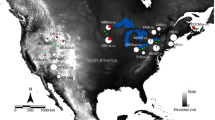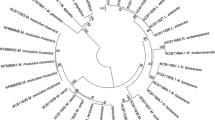Abstract
Chytrid fungus Batrachochytrium dendrobatidis (Bd), an emerging disease, has been decimating amphibian populations around the world for several decades. We quantified aspects of larval fitness, adaptive (major histocompatibility complex) diversity and neutral (microsatellite) diversity in natterjack toad (Bufo calamita) populations in two regions of north-west England. Toads in region one had no evidence of chytrid infection, whereas in region two there was a substantial prevalence of Bd. Larval fitness (growth rate, time to metamorphosis and survival) of B. calamita did not differ between the regions. Genetic diversity at microsatellite loci was much higher in the infected than in the uninfected region, but the converse was true of MHC diversity indicating that genetic drift was unlikely to explain the differences in MHC between the regions. Furthermore, MHC allele frequencies varied significantly between Bd-infected and uninfected populations. Microsatellite diversity was not a robust indicator of larval fitness in these toad populations while MHC genotype frequencies varied in a way that was consistent with directional selection in response to pathogen prevalence. The acquired immune defences may therefore play an important role in determining the susceptibility of amphibian species to chytridiomycosis.

Similar content being viewed by others
References
Antao T, Lopes RJ, Beja-Pereira A, Luikart K (2008) LOSITAN: a workbench to detect molecular adaptation based on a Fst-outlier method. BMC Bioinform 9:323
Arai S (2008) Investigation on the spread of chytridiomycosis between UK natterjack toads and other inland amphibian populations in Cumbria. MSc thesis, Imperial College, London
Babik W, Pabijan M, Arntzen JW, Cogãlniceanu D, Durka W, Radwan J (2009) Long-term survival of a urodele amphibian despite depleted major histocompatibility complex variation. Mol Ecol 18:769–781
Beebee TJC (1977) Environmental change as a cause of natterjack toad (Bufo calamita) declines in Britain. Biol Conserv 11:87–102
Beebee TJC, Griffiths RA (2005) The amphibian decline crisis: a watershed for conservation biology? Biol Conserv 125:271–285
Beebee TJC, Wilkinson JW, Buckley J (2009) Amphibian declines are not uniquely high amongst the vertebrates: trend determination and the British perspective. Diversity 1:67–88
Biedrzycka A, Radwan J (2008) Population fragmentation and major histocompatibility complex variation in the spotted suslik, Spermophilus suslicus. Mol Ecol 17:4801–4811
Boyle DG, Boyle DB, Olsen V, Morgan JAT, Hyatt AD (2004) Rapid quantitative detection of chytridiomycosis (Batrachochytrium dendrobatidis) in amphibian samples using real-time Taqman PCR assay. Dis Aquat Org 60:141–148
Buckley J, Beebee TJC (2004) Monitoring the conservation status of an endangered amphibian: the natterjack toad Bufo calamita in Britain. Anim Conserv 7:221–228
Cunningham AA, Minting P (2008) National survey of Batrachochytrium dendrobatidis infection in amphibians, 2008. Unpublished report to Natural England
Cunningham AA, Garner TWJ, Aguillar-Sanchez V, Banks B, Foster J, Sainsbury AW, Perkins M, Walker SF, Hyatt AD, Fisher MC (2005) Emergence of amphibian chytridiomycosis in Britain. Vet Rec 157:386–387
Dionne M, Miller KM, Dodson JJ, Bernatchez L (2009) MHC standing genetic variation and pathogen resistance in wild Atlantic Salmon. Philos Trans R Soc B 364:1555–1565
Ficetola GF, Garner TWJ, De Bernardi F (2007) Genetic diversity, but not hatching success, is jointly affected by postglacial colonisation and isolation in the threatened frog, Rana latastei. Mol Ecol 16:1787–1797
Fisher MC, Garner TWJ, Walker SF (2009) Global emergence of Batrachochytrium dendrobatidis and amphibian chytridiomycosis in space, time and host. Annu Rev Microbiol 63:291–310
Garner TWJ, Walker S, Bosch J, Leech S, Rowcliffe JM, Cunningham AA, Fisher MC (2009) Life history tradeoffs influence mortality associated with the amphibian pathogen Batrachochytrium dendrobatidis. Oikos 118:783–791
Gosner KL (1960) A simplified table for staging anuran embryos and larvae with notes on identification. Herpetologica 16:183–190
Goudet J (2001) FSTAT: a program to estimate and test gene diversities and fixation indices, Version 2.9.3. Lausanne University, Lausanne, Switzerland
Hansson B, Westerberg L (2002) On the correlation between heterozygosity and fitness in natural populations. Mol Ecol 11:2467–2474
Houlahan JE, Findlay CS, Schmidt BR, Meyer AH, Kuzmin SL (2000) Quantitative evidence for global amphibian population declines. Nature 404:752–755
Martinez-Solano I, Bosch J, Garcia-Paris M (2003) Demographic trends and community stability in a montane amphibian assemblage. Conserv Biol 17:236–244
Mason RAB, Browning TC, Eldridge MDB (2009) Reduced MHC class II diversity in island compared to mainland populations of the black-footed rock-wallaby (Petrogale lateralis lateralis). Conserv Genet. doi:10.1007/s10592-009-9993-y
May S, Beebee TJC (2009) Characterisation of major histocompatibility complex class II alleles in the natterjack toad, Bufo calamita. Conserv Genet Res 1:415–417
Meyer-Lucht Y, Sommer S (2005) MHC diversity and the association to nematode parasitism in the yellow-necked mouse (Apodemus flavicollis). Mol Ecol 14:2233–2243
Peakall R, Smouse PE (2006) GENALEX 6: genetic analysis in Excel, population genetic software for teaching and research. Mol Ecol Notes 6:288–295
Piertney SB, Oliver MK (2006) The evolutionary ecology of the major histocompatibility complex. Heredity 96:7–21
Ramsey JP, Reinert LK, Harper LK, Woodhams DC, Rollins-Smith LA (2010) Immune defences against Batrachochytrium dendrobatidis, a fungus linked to global amphibian declines, in the South African clawed frog, Xenopus laevis. Infect Immun 78:3981–3992
Reed DH, Frankham R (2003) Correlation between fitness and genetic diversity. Conserv Biol 17:230–237
Richmond JQ, Savage AE, Zamudio KR, Rosenblum EB (2009) Toward immunogenetic studies of amphibian chytridiomycosis: linking innate and acquired immunity. Bioscience 59:311–320
Rowe G, Beebee TJC (2001) Fitness and microsatellite diversity estimates were not correlated in two outbred anuran populations. Heredity 87:558–565
Rowe G, Beebee TJC (2003) Population on the verge of a mutational meltdown? Fitness costs of genetic load for an amphibian in the wild. Evolution 57:177–181
Rowe G, Beebee TJC (2005) Intraspecific competition disadvantages inbred natterjack toad (Bufo calamita) genotypes over outbred ones in a shared pond environment. J Anim Ecol 74:71–76
Rowe G, Beebee TJC (2007) Defining population boundaries: use of three Bayesian approaches with microsatellite data from British natterjack toads (Bufo calamita). Mol Ecol 16:785–796
Rowe G, Beebee TJC, Burke T (1997) PCR primers for polymorphic microsatellite loci in the anuran amphibian Bufo calamita. Mol Ecol 6:401–402
Rowe G, Beebee TJC, Burke T (1998) Phylogeography of the natterjack toad Bufo calamita in Britain: genetic differentiation of native and introduced populations. Mol Ecol 7:751–760
Rowe G, Beebee TJC, Burke T (1999) Microsatellite heterozygosity, fitness and demography in natterjack toads Bufo calamita. Anim Conserv 2:85–92
Stuart SN, Chanson JS, Cox NA, Young BE, Rodrigues ASL, Fischmann DL, Waller RW (2004) Status and trends of amphibian declines and extinctions worldwide. Science 306:1783–1786
Teacher AGF, Garner TWJ, Nichols RA (2009) Evidence for directional selection at a novel major histocompatibility class I marker in wild common frogs (Rana temporaria) exposed to a viral pathogen (ranavirus). PLoS One 4:e4616. doi:10.1371/journal.pone.0004616)
Walker SF, Bosch J, Gomez V, Garner TWJ, Cunningham AA, Schmeller DS, Ninyerola M, Henk DA, Ginestet C, Arthur CP, Fisher MC (2010) Factors driving pathogenicity vs. prevalence of amphibian panzootic chytridiomycosis in Iberia. Ecol Lett 13:372–382
Whitlock MC (2008) Evolutionary inference from Q st. Mol Ecol 17:1885–1896
Woodhams DC, Ardipradja K, Alford RA, Marantelli G, Reinert LK, Rollins-Smith LA (2007) Resistance to chytridiomycosis varies among amphibian species and is correlated with skin peptide defences. Anim Conserv 10:409–417
Zeisset I, Beebee TJC (2009) Molecular characterisation of MHC class II alleles in the common frog Rana temporaria. Mol Ecol Res 9:738–745
Acknowledgments
We thank the landowners and managers (especially Richard Irving and Pete Burton) who gave us permission to take natterjack spawn samples, Dave Coward for assistance with the sampling, Andrew Cunningham and Peter Minting for permission to use unpublished information concerning Bd status in the study populations, three anonymous referees for helpful comments, and the Leverhulme Trust and Amphibian Conservation Research Trust for financial support. The work was carried out under UK Home Office licence PPL 70/6295.
Author information
Authors and Affiliations
Corresponding author
Rights and permissions
About this article
Cite this article
May, S., Zeisset, I. & Beebee, T.J.C. Larval fitness and immunogenetic diversity in chytrid-infected and uninfected natterjack toad (Bufo calamita) populations. Conserv Genet 12, 805–811 (2011). https://doi.org/10.1007/s10592-011-0187-z
Received:
Accepted:
Published:
Issue Date:
DOI: https://doi.org/10.1007/s10592-011-0187-z




